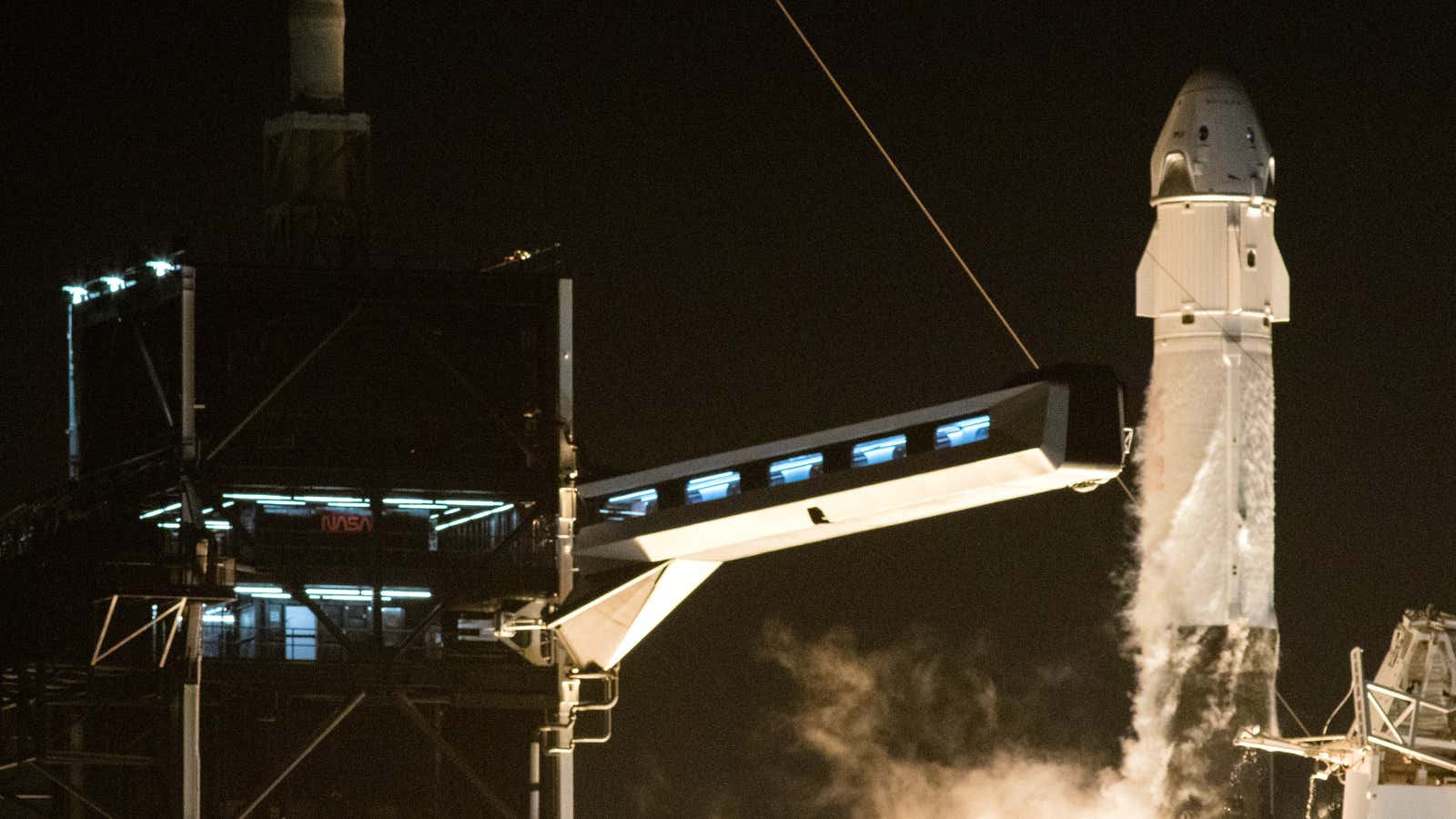The four astronauts now on their way to the International Space Station are marking several firsts—the SpaceX Dragon’s first flight after being officially certified by NASA to fly humans, the first international astronaut onboard a commercial spacecraft, and the first time NASA has packed four people in a space capsule.
It’s also the first time the Federal Aviation Administration has licensed a crewed mission for the US space agency—the FAA has been licensing satellite launches since 1989, but flying astronauts to orbit was government business. The arrival of privately operated human spacecraft is changing that: Most NASA staff fly commercial when they travel between terrestrial research centers, and now they’ll do the same when they head for the national laboratory in orbit.
The pivot is a testament to the vision of commercial space advocates, in and out of government, since NASA began seriously investing in private spaceflight under president George W. Bush. That investment, expanded under subsequent presidents, enabled Elon Musk and his team to develop cost-saving innovations and make SpaceX one of the world’s most valuable private companies.
SpaceX transports cargo into space for the US government, foreign governments, and private firms around the world. Now, it can fly people, too, for governments and private companies—Axiom Space, a new space tourism company, announced that three private astronauts booked a Dragon for a trip to the ISS later in 2021. SpaceX is also a major satellite manufacturer and operator, and with its Starlink network, has set its sights on being a telecommunications provider as well.
There are other conglomerates that make space products, Boeing and Lockheed Martin chief among them. But neither firm has combined hardware and services up and down the value chain the way SpaceX has. Lockheed, for example, does not operate satellites, and Boeing began offering services to NASA after SpaceX pioneered the business model. That makes it the first real vertically integrated space company, and the mainstream business press is finally starting to notice.
How the US government created aerospace conglomerates
There are a lot of metaphors for efforts to commercialize government technology, and every single one has been deployed on behalf of the space industry. It’s like the internet, you see, or the transcontinental railroad, or maybe dirigibles. (I made the last one up.) One favored comparison, not as widely known today, was the Air Mail fiasco that birthed the modern aviation industry.
Nearly a century ago, a US law known as the Kelly Act began subsidizing payments to private airlines that delivered mail for the US postal service. The work was effective, but the perception that government insiders handed contracts to favored firms who colluded to divide up the routes became a political scandal. But, after the Army Air Corps proved unable to do the job safely, mail delivery was handed back to the private sector with a more thought-through approach.
This government investment led to the US aviation industry we know today, and explicitly inspired the NASA commercial cargo program that boosted SpaceX in its early days and brought us to this new era of private spaceflight.
Indeed, while Elon Musk is often compared to Howard Hughes, Bill Boeing might be the more apt business comparison. Boeing started off as an enthusiast (a lumber heir at a time when airplanes were made of wood) but quickly saw opportunity in improving the nascent technology.
“He was kind of the Bill Gates of his day,” Boeing historian Michael Lombardi told me in 2016. “And the airplane companies were much like the computer companies, their stock was going through the roof, and they were very successful, because of this new technology.”
Boeing, like Musk, believed in vertical integration and quickly assembled a firm that not only sold engines and airplanes, but flew them. This helped him become the leading figure in the American aviation industry—and the target of Congressional critics who saw monopolistic American airline manufacturers overcharging the government for military aircraft. (Picture the saga of the F-35, but with biplanes.)
“They didn’t find any wrongdoing, but they did decide that airline manufacturers should not also fly,” Lombardi said. “And with that, Boeing broke up his mega-corporation. “
Boeing remained an aerospace hardware manufacturer, while its airlines became United Airlines and the rest of the firm became the precursor for United Technologies. This experience may help explain the reluctance of major aerospace companies to integrate their space business lines, or why some SpaceX insiders expect the company’s satellite network to eventually be spun out through an IPO. One thing is for sure: It’s hard to imagine Musk throwing up his hands in the face of a battle with government regulators and retiring the way Boeing ultimately did.
And yet the future of the economy in low-earth orbit may depend on today’s Boeing—or Jeff Bezos’ Blue Origin—meeting SpaceX’s challenge. An obvious lesson of aviation industry is avoiding monopolies and incentivizing competition. NASA officials say they have taken this philosophy to heart. While SpaceX’s new vehicle is the cheapest ever made to fly people into space, tickets cost roughly $60 million per seat. That makes it both a giant leap forward for space travel—and still many times removed from the everyday relevance of a propeller plane in 1930.
“These are going to be very expensive,” Phil McAlister, NASA’s director of commercial spaceflight, said last week of private activity in low-earth orbit. “My hope is we will see more entrepreneurs enter this market. You generally see that makes things more cost effective going forward.”
A version of this story first appeared in Quartz’s Space Business newsletter.
